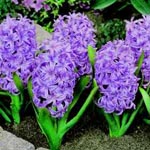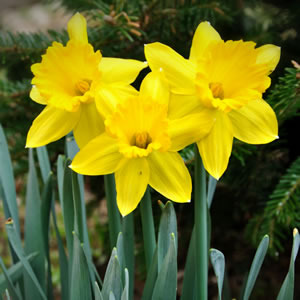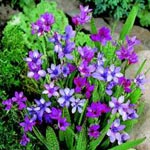Spring Bulb Information
From small beginnings
Have you ever wondered how all those millions of little bulbs are produced every year for gardeners all over Australia?
The answer for many varieties such as Ranunculi, Anemone, Ixia, Freesias, Sparaxis, and Babiana lies in the wonder of multiplication by seed. Millions of tiny, hand picked seeds are drilled or broadcast over hectares of land in Geelong’s Bellarine Peninsula.
In mid winter, 1 to 2 months after planting, and the ground never being allowed to dry out, a tiny hair-like seedling appears . There are no chemicals delicate enough to control the weeds in these crops without harming the seedlings, so every weed will be removed by hand for the next six months.
As warmer weather and longer days approach the tiny seedlings begin to grow rapidly. In November a glorious transformation takes place, with millions of flowers bursting into colour.
In December as the foliage naturally dies down, a new healthy bulb will have formed under every plant, ready to dig, wash, dry, grade and clean before sending the best to Garden Express customers.
Bulbs for you
 Spring would not be the same without the whole magical world of bulbs. Think of spring and a picture of golden yellow daffodils immediately comes to mind, they certainly brighten up the grey winters. But why be thinking of spring bulbs now at this time of the year? Bulbs do need some forethought, by planting them now even though you see little happening for several months you can be assured of a myriad of colour in spring.
Spring would not be the same without the whole magical world of bulbs. Think of spring and a picture of golden yellow daffodils immediately comes to mind, they certainly brighten up the grey winters. But why be thinking of spring bulbs now at this time of the year? Bulbs do need some forethought, by planting them now even though you see little happening for several months you can be assured of a myriad of colour in spring.
There are bulbs to suit every climate in the country, though daffodils and hyacinths are happiest in cool to mild areas. You can grow bulbs in rock gardens, or have them in large drifts under deciduous trees, or in smaller gardens grow them in pots. If space is a problem plant bulbs amongst other shrubs and flowering annuals so there is something more to look at when bulb flowering is finished.
To grow bulbs successfully
 Most spring bulbs need to be planted five or six months ahead of flowering time, that is the necessity of planning right now. Normally they are happy in good, well drained soil with some old compost or well rotted manure added. Do not use fresh manure as this can burn the bulbs. A cup of complete garden fertiliser per square metre can be forked in to a depth of 20 centimetres.
Most spring bulbs need to be planted five or six months ahead of flowering time, that is the necessity of planning right now. Normally they are happy in good, well drained soil with some old compost or well rotted manure added. Do not use fresh manure as this can burn the bulbs. A cup of complete garden fertiliser per square metre can be forked in to a depth of 20 centimetres.
Generally bulbs need sunlight to flower properly, this is very often the reason why daffodils fail to flower a second season. Do no expect them to flower well under the canopy of leafy trees such as eucalypts which give too much shade; however, under deciduous trees such as silver birch they are rewarding. A few bulbs like bluebells (Scilla), cyclamen and muscari will grow in moderate shade.
Nature’s wonder
 For best effect you can plant daffodils in clumps, perhaps 1 – 2 metres in size as it looks more natural than in rows. Other bulbs such as fragrant freesias are best planted as a loose growing edge to a garden bed, while the orange soldier boys (Lachenalia) and blue grape hyacinths can be lined up in straight rows in the front of a flower bed were they look perfectly neat and lovely. Bulbs are a storehouse of food – they are remarkable little things, capable of remaining dormant under the ground for months. From their reserve of energy they then produce lovely flowers and leaves that can last for long periods. But you must allow the leaves to die back on the bulb, replenishing it after flowering so that it gets enough strength to produce a flower the following year. This usually happens towards the end of spring, after which you can lift and store the bulbs in a cool, dry spot with good air movement. However, many bulbs need not be lifted out of the ground for years, if at all. Daffodils can left to naturalise and will grow happily in the same position for years. Left in the ground, new bulbs will form at the side and base of the original bulb and can be separated off.
For best effect you can plant daffodils in clumps, perhaps 1 – 2 metres in size as it looks more natural than in rows. Other bulbs such as fragrant freesias are best planted as a loose growing edge to a garden bed, while the orange soldier boys (Lachenalia) and blue grape hyacinths can be lined up in straight rows in the front of a flower bed were they look perfectly neat and lovely. Bulbs are a storehouse of food – they are remarkable little things, capable of remaining dormant under the ground for months. From their reserve of energy they then produce lovely flowers and leaves that can last for long periods. But you must allow the leaves to die back on the bulb, replenishing it after flowering so that it gets enough strength to produce a flower the following year. This usually happens towards the end of spring, after which you can lift and store the bulbs in a cool, dry spot with good air movement. However, many bulbs need not be lifted out of the ground for years, if at all. Daffodils can left to naturalise and will grow happily in the same position for years. Left in the ground, new bulbs will form at the side and base of the original bulb and can be separated off.
To look even better
You can grow shallow rooted flowering annuals around the bulbs, lovely displays of violas, pansies, sweet Alice, forget-me-not or Virginian stock that can be matched or contrasted in colour to your choice of bulbs. As the leaves of bulbs must be left to die off naturally, at least these seedlings continue on the colour for a bit longer.






